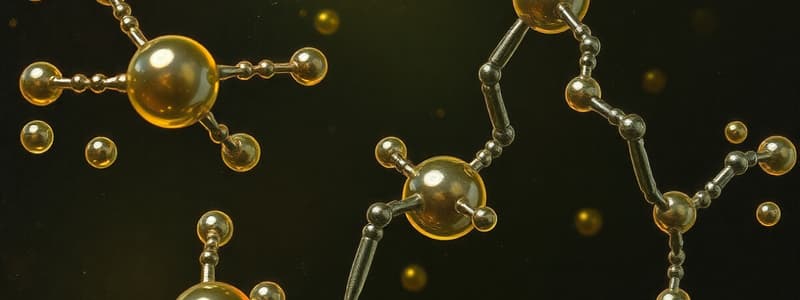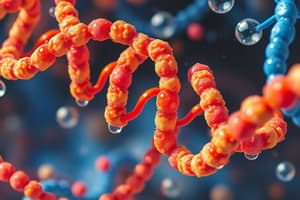Podcast
Questions and Answers
What are the primary components that form phospholipids?
What are the primary components that form phospholipids?
- Glycerol, fatty acids, and charged groups (correct)
- Cholesterol, triglycerides, and amino acids
- Triglycerides, steroids, and polysaccharides
- Fatty acids, amino acids, and glucose
Which type of fatty acid has all carbon atoms linked by single covalent bonds?
Which type of fatty acid has all carbon atoms linked by single covalent bonds?
- Hydrophobic fatty acids
- Polyunsaturated fatty acids
- Unsaturated fatty acids
- Saturated fatty acids (correct)
Which of the following is NOT a function of lipids?
Which of the following is NOT a function of lipids?
- Insulation
- Hormone production
- Energy source
- Carbon storage (correct)
What is the structural feature of phospholipids that allows them to interact with water?
What is the structural feature of phospholipids that allows them to interact with water?
Which macromolecule is primarily based on amino acid monomers?
Which macromolecule is primarily based on amino acid monomers?
Which group of bonds holds together the complementary bases in the DNA double helix?
Which group of bonds holds together the complementary bases in the DNA double helix?
What is the primary function of nucleotides in nucleic acids?
What is the primary function of nucleotides in nucleic acids?
What distinguishes RNA from DNA in terms of chain structure?
What distinguishes RNA from DNA in terms of chain structure?
Which of the following correctly describes a difference between the sugars found in DNA and RNA?
Which of the following correctly describes a difference between the sugars found in DNA and RNA?
Which statement about amino acids is true?
Which statement about amino acids is true?
What mass of glucose is required to prepare 1 liter of a 1 M glucose solution?
What mass of glucose is required to prepare 1 liter of a 1 M glucose solution?
Which of the following correctly describes polar compounds?
Which of the following correctly describes polar compounds?
What type of compound does NaCl represent in relation to water?
What type of compound does NaCl represent in relation to water?
What defines an ion?
What defines an ion?
Which of the following organic molecules is NOT one of the four main types?
Which of the following organic molecules is NOT one of the four main types?
What is the primary function of carbohydrates in biological systems?
What is the primary function of carbohydrates in biological systems?
Which type of bond involves the sharing of electrons?
Which type of bond involves the sharing of electrons?
What structural difference exists between glucose and galactose?
What structural difference exists between glucose and galactose?
Which strength classification accurately refers to ionic bonds?
Which strength classification accurately refers to ionic bonds?
What is the result of sharing electrons more favorably with a larger atom?
What is the result of sharing electrons more favorably with a larger atom?
What type of bond primarily links monosaccharides to form disaccharides?
What type of bond primarily links monosaccharides to form disaccharides?
Which statement about molecular weight (MW) is correct?
Which statement about molecular weight (MW) is correct?
What is glycogen primarily used for in living organisms?
What is glycogen primarily used for in living organisms?
In a chemical solution, what does the term 'chemical concentration' refer to?
In a chemical solution, what does the term 'chemical concentration' refer to?
Which of the following correctly represents a chlorine ion that has gained an electron?
Which of the following correctly represents a chlorine ion that has gained an electron?
What type of molecular interaction is represented by the attraction between hydrogen and oxygen or nitrogen?
What type of molecular interaction is represented by the attraction between hydrogen and oxygen or nitrogen?
Flashcards
What is an ion?
What is an ion?
An atom that has gained or lost one or more electrons, resulting in an imbalance of protons and electrons, giving it a net electrical charge.
Covalent bond
Covalent bond
The chemical bond formed when two atoms share electrons.
Ionic bond
Ionic bond
The chemical bond formed by the electrostatic attraction between oppositely charged ions.
Hydrogen bond
Hydrogen bond
Signup and view all the flashcards
Van der Waals forces
Van der Waals forces
Signup and view all the flashcards
Chemical Concentration
Chemical Concentration
Signup and view all the flashcards
Molecular Weight
Molecular Weight
Signup and view all the flashcards
1 Molar Solution (1M)
1 Molar Solution (1M)
Signup and view all the flashcards
What are triglycerides?
What are triglycerides?
Signup and view all the flashcards
What are phospholipids?
What are phospholipids?
Signup and view all the flashcards
What are steroids?
What are steroids?
Signup and view all the flashcards
What are fatty acids?
What are fatty acids?
Signup and view all the flashcards
What is the difference between saturated and unsaturated fatty acids?
What is the difference between saturated and unsaturated fatty acids?
Signup and view all the flashcards
Polar compound
Polar compound
Signup and view all the flashcards
Non-polar compound
Non-polar compound
Signup and view all the flashcards
Hydrophilic
Hydrophilic
Signup and view all the flashcards
Hydrophobic
Hydrophobic
Signup and view all the flashcards
Association
Association
Signup and view all the flashcards
Organic molecules
Organic molecules
Signup and view all the flashcards
Carbohydrates
Carbohydrates
Signup and view all the flashcards
Monosaccharide
Monosaccharide
Signup and view all the flashcards
What are proteins made of and how are they linked?
What are proteins made of and how are they linked?
Signup and view all the flashcards
How are amino acid side chains important?
How are amino acid side chains important?
Signup and view all the flashcards
What is the structure of DNA?
What is the structure of DNA?
Signup and view all the flashcards
How does RNA differ from DNA?
How does RNA differ from DNA?
Signup and view all the flashcards
What are the building blocks of nucleic acids?
What are the building blocks of nucleic acids?
Signup and view all the flashcards
Study Notes
Chemical Composition of the Body
- Humans are complex systems composed of tissues and organ systems.
- Organ systems contain extracellular matrices and cells.
- Cells are composed of organelles and molecules.
- Molecules are collections of atoms held together by chemical bonds.
- Atoms are made up of subatomic particles: a nucleus with protons and neutrons, and surrounding electrons.
Ions
- An ion results when an atom gains or loses one or more electrons, leading to an electrical charge.
- The charge is indicated using plus and minus signs.
- The number of plus or minus signs indicates the number of electrons gained or lost.
- Examples: Cl⁻ represents a chlorine atom that gained an electron, Ca²⁺ represents a calcium atom that lost two electrons.
Molecular Structure
- Several ways exist to represent molecular structure which helps understand function.
- Two-dimensional representations show the connectivity of atoms.
- Three-dimensional models provide a better visualization of the molecule's shape.
- Space-filling models illustrate the relative sizes of atoms in a molecule.
- Examples given for two-dimensional and three-dimensional representations include methane (CH₄) and ammonia (NH₃).
Chemical Bonds and Interactions
- Strong Bonds:
- Covalent bonds: atoms share electrons, seen in methane (CH₄)
- Ionic bonds: opposite charges attract (e.g., sodium chloride, Na⁺Cl⁻).
- Weak Interactions:
- Hydrogen bonds: attraction between a hydrogen atom and an electronegative atom (e.g., oxygen or nitrogen). This is shown in water molecules.
- Van der Waals forces: weak, short-range attractive forces between molecules.
Solvent + Solute(s) = A Chemical Solution
- A solution consists of a solvent and one or more solutes.
- Chemical concentration measures the amount of solute dissolved in the solvent.
- Molecular weight (MW) is the mass in grams of one mole of a solute.
- One molar (1M) solution contains one mole of solute per liter of solvent.
- Example: glucose (C₆H₁₂O₆) has a MW of 180 g/mol, so a 1 M solution requires 180 grams of glucose dissolved in 1 liter of water.
Polar and Non-polar Bonds
- Polar compounds have atoms with opposite charges at each end (e.g., water). They readily associate with each other.
- Nonpolar compounds have atoms with similar charges at each end (e.g., some hydrocarbons). They readily associate with each other.
- Hydrophilic molecules dissolve readily in water.
- Hydrophobic molecules do not dissolve readily in water but often dissolve in nonpolar solvents.
NaCl Dissolves in Water
- Sodium chloride (NaCl) consists of Na⁺ and Cl⁻ ions.
- Water, due to its polarity, dissolves Na⁺ and Cl⁻ ions, forming a solution.
- Water molecules surround and dissolve Na⁺ and Cl⁻.
- Na⁺ and Cl⁻ are solutes, and water is the solvent.
Non-polar and Polar regions
- Non-polar regions associate with each other.
- Polar regions form hydrogen bonds with polar water molecules.
Organic Molecules
- Organic molecules contain carbon (C) and hydrogen (H)
- Four main types: carbohydrates, lipids, proteins, and nucleic acids.
Carbohydrates
- Structure: sugars and starches; contain C, H, O (often with hydroxyl OH groups linked to carbons.) They are characterized as covalent bonded chains.
- Function: energy storage and production.
- Examples: glucose, fructose, sucrose, glycogen.
Lipids
- Structure: based on fatty acid monomers; long hydrocarbon chains, can be saturated (single bonds) or unsaturated (double bonds).
- Function: energy storage, cell membranes, hormones, insulation.
- Examples: triglycerides, phospholipids, steroids, cholesterol.
Proteins
- Structure: based on amino acid monomers; diverse shapes with different levels of structures, contain C, H, O, N (often with sulfur), with covalent bonds between amino acids.
- Function: many roles, including enzymes, cell attachment, cytoskeleton, locomotion, and hormones.
- All amino acids share an amino group and a carboxyl group and vary with their differing "side chains." Side chains can be nonpolar, polar, or ionized.
Nucleic Acids (Nucleotides)
- Structure: sugar + bases + phosphate; repeating units (nucleotides) in a chain.
- Functions: information storage (DNA and RNA), energy storage and transfer (ATP), coenzymes.
- DNA: deoxyribose sugar, contains four bases (adenine, guanine, cytosine, and thymine); double helix.
- RNA: ribose sugar, contains four bases (adenine, guanine cytosine, and uracil); single strand.
DNA and RNA Comparison
- Structure and function differ in the sugars, bases and chain quantities, and overall structure.
Studying That Suits You
Use AI to generate personalized quizzes and flashcards to suit your learning preferences.





